Italeri 1/72 C-130J Hercules
|
KIT #: |
1255 |
|
PRICE: |
36 Euros (a LOT more in the US) |
|
DECALS: |
Three options |
|
REVIEWER: |
Carmel J. Attard |
|
NOTES: |
|
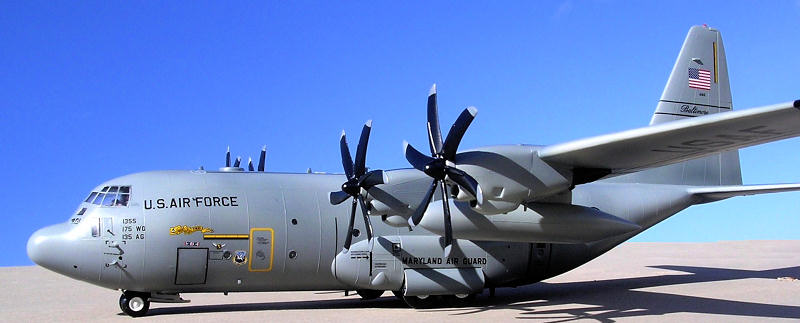
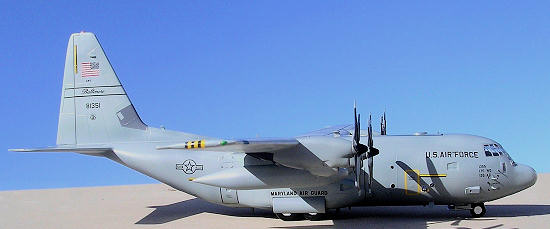 While it maintains the familiar lines of the Hercules, by now is a common
sight in the world skies and for decades to come, the C-130J has been
extensively re-designed. The most visible change lies in the use of four-4700 HP
Rolls Royce (Allison) AE21003 engines, with six-blade composite material
propellers that ensure silent running and low fuel consumption. High performance
features include an excellent rate of climb and an extended range of action
thanks to the new engines. An equally important development is the avionics: the
cockpit in fact, is equipped with new digital instruments and a Head-Up Display
that provide the pilot with a constant stream of data without him having to look
away from the cockpit window. The C-130J is steadily becoming the standard
transport aircraft in many Nato countries,
Italy
included.
While it maintains the familiar lines of the Hercules, by now is a common
sight in the world skies and for decades to come, the C-130J has been
extensively re-designed. The most visible change lies in the use of four-4700 HP
Rolls Royce (Allison) AE21003 engines, with six-blade composite material
propellers that ensure silent running and low fuel consumption. High performance
features include an excellent rate of climb and an extended range of action
thanks to the new engines. An equally important development is the avionics: the
cockpit in fact, is equipped with new digital instruments and a Head-Up Display
that provide the pilot with a constant stream of data without him having to look
away from the cockpit window. The C-130J is steadily becoming the standard
transport aircraft in many Nato countries,
Italy
included.
 This is
the same Italeri kit of C-130E and H of early 80s with updated injected parts
that come as addition new sprues. Despite the age there is not the faintest hint
of flash and the clear parts are commendably transparent. Moulded in grey
plastic a short fuselage C-130J can be produced. The Photographic Reference
Manual provided also suggests details and accurate dimensions to enable one make
the stretched C-130J where an extension cut from an additional fuselage taken
from another kit having a staggered joint can be worked out or the extension
part can be scratch built. Using this method any of the longer versions
(L-100-30, C-130H-30 etc) can be made.
This is
the same Italeri kit of C-130E and H of early 80s with updated injected parts
that come as addition new sprues. Despite the age there is not the faintest hint
of flash and the clear parts are commendably transparent. Moulded in grey
plastic a short fuselage C-130J can be produced. The Photographic Reference
Manual provided also suggests details and accurate dimensions to enable one make
the stretched C-130J where an extension cut from an additional fuselage taken
from another kit having a staggered joint can be worked out or the extension
part can be scratch built. Using this method any of the longer versions
(L-100-30, C-130H-30 etc) can be made.
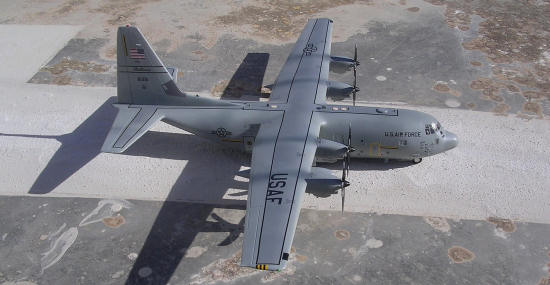 One can
follow the 10-page folding instruction sheet stage by stage and there are 9
stages. Colour data is also provided where each component is clearly marked with
a colour reference letter. There are a few components that you would not need
and these are clearly marked.
I did not fit the refuelling probe
as the particular type I made did not have one fitted.
One can
follow the 10-page folding instruction sheet stage by stage and there are 9
stages. Colour data is also provided where each component is clearly marked with
a colour reference letter. There are a few components that you would not need
and these are clearly marked.
I did not fit the refuelling probe
as the particular type I made did not have one fitted.
I chose to build the
Maryland
Air National Guard aircraft even though the detail pictures dealt mainly with
the Italian and the RAF C130J. I had to assume that what detail there was on
these also applied to the
US
aircraft. Even so the clear art work on the box cover also provided good clues
for surface detail The surface panel lines on all parts is raised and the
original Allison T-56A engines are now replaced wit a new set of the later
Allison AE 2100 D3 Turboprops. For the C-130J a minor modification consisting of
cutting off the earlier beaver tail which is then replaced with the recent
version.
Other exterior alterations come in
different antennae and air intake scoops. This also reveals that some of the
chaff and flare dispensers and warning systems are absent in the kit. When it
comes to the nose area for details the instruction sheet gave brief
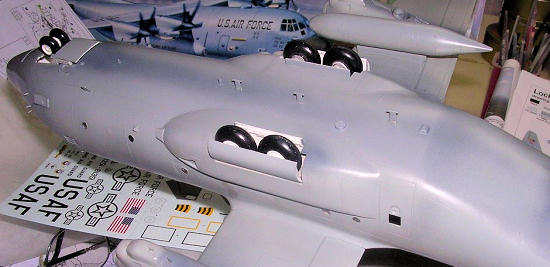 indications
and reference to the manual photos was the answer. Alterations to the nose area
consisted of blanking one on each side of the nose of the vertical rectangular
windows; these were also faired with filler. The lower two front square windows
were also blanked. On top of these I added sensors as shown on close up photos
in the manual on P15. As for the interior a new instrument panel for the upgrade
C-130J is provided. Otherwise the interior remains fairly basic and if left with
the rear loading door open there is scope for a lot of detail to add. The rear
cargo hatches and ramp also required additional detail. I had no plans to leave
the cargo door and side doors in the open position and so much for additional
internal detail. However there is a conspicuous embossed panel right on the
outside and in the middle of the ramp. This is shown in great detail on P38
where the raised panel is faired at the sides. Other additions were altering the
aerials and antennae in both shape and their location on the fuselage. The only
difficulty encountered was with narrow gaps when the ramp was fixed in place.
These were fixed with super glue and a little amount of ‘Plasto’ filler followed
by smooth sanding.
indications
and reference to the manual photos was the answer. Alterations to the nose area
consisted of blanking one on each side of the nose of the vertical rectangular
windows; these were also faired with filler. The lower two front square windows
were also blanked. On top of these I added sensors as shown on close up photos
in the manual on P15. As for the interior a new instrument panel for the upgrade
C-130J is provided. Otherwise the interior remains fairly basic and if left with
the rear loading door open there is scope for a lot of detail to add. The rear
cargo hatches and ramp also required additional detail. I had no plans to leave
the cargo door and side doors in the open position and so much for additional
internal detail. However there is a conspicuous embossed panel right on the
outside and in the middle of the ramp. This is shown in great detail on P38
where the raised panel is faired at the sides. Other additions were altering the
aerials and antennae in both shape and their location on the fuselage. The only
difficulty encountered was with narrow gaps when the ramp was fixed in place.
These were fixed with super glue and a little amount of ‘Plasto’ filler followed
by smooth sanding.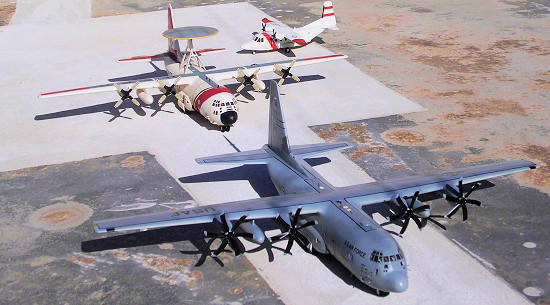
It is essential to add
weight to the nose area in order to balance the kit on the nose. The new engines
and six blade propellers made the principal difference in appearance to the
earlier C-130 Hercules I made. Reference to additional photos I downloaded from
Internet showed that additional aerials and antennae were fitted to the type.
These had to be made from plastic card. The final assembly was the tailpiece
that was replaced with a different one supplied. In the end the undercarriage
was fixed in place making sure that the 6 wheels were all level and all touched
the ground. The propellers were left to a stage after the painting and decals
are complete. Each of these simply locates on a small round platform, which can
be fixed to rotate on small shafts. Prior to painting I masked all clear areas
using a mix of Humbrol Maskol and Tamiya tape.
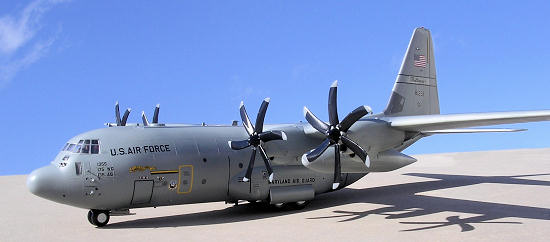 The
entire model was airbrushed in Neutral grey FS36173, Model Master aircraft grey
ADC1731E.
Then blended areas with a darker or lighter shade in way of erosion or exhaust
flow from the Allison engine. The model was then given an overall coat of
Johnson’s Klear. Decals are accurate in colour and in perfect register. They
also have good fixing properties and are therefore very good. These include also
all formation lights and walkway lines on top of wings and fuselage. Decals were
applied a little at a time working from those that fits under the wings, then on
fuselage sides and finally on the fuselage and main planes. Most of the interior
was light grey. The exhaust path under the wings was painted black. The only
additions I made to the cockpit interior were painted tape to represent seat
straps/harnesses. In the end I sprayed the entire model in semi matt transparent
lacquer. Light coats of engine grey mixed with lots of Lacquer gave indication
of wear across loading ramp and side doors.
The
entire model was airbrushed in Neutral grey FS36173, Model Master aircraft grey
ADC1731E.
Then blended areas with a darker or lighter shade in way of erosion or exhaust
flow from the Allison engine. The model was then given an overall coat of
Johnson’s Klear. Decals are accurate in colour and in perfect register. They
also have good fixing properties and are therefore very good. These include also
all formation lights and walkway lines on top of wings and fuselage. Decals were
applied a little at a time working from those that fits under the wings, then on
fuselage sides and finally on the fuselage and main planes. Most of the interior
was light grey. The exhaust path under the wings was painted black. The only
additions I made to the cockpit interior were painted tape to represent seat
straps/harnesses. In the end I sprayed the entire model in semi matt transparent
lacquer. Light coats of engine grey mixed with lots of Lacquer gave indication
of wear across loading ramp and side doors.
I like the overall sit
of the attractive aircraft complete with a good choice of decals. The kit was
practically built straight from the box with minor additional detail to the
exterior. The C130 J contrasted well with a previous C-130 built in USCG livery.
I recommend the kit to anyone with average skill and certainly a must for those
keen on present day transport aircraft.
Carmel J. Attard
November 2010
If you would like your product reviewed fairly and quickly, please
contact
me or see other details in the
Note to
Contributors.
Back to the Main Page
Back to the Review
Index Page


 While it maintains the familiar lines of the Hercules, by now is a common
sight in the world skies and for decades to come, the C-130J has been
extensively re-designed. The most visible change lies in the use of four-4700 HP
Rolls Royce (Allison) AE21003 engines, with six-blade composite material
propellers that ensure silent running and low fuel consumption. High performance
features include an excellent rate of climb and an extended range of action
thanks to the new engines. An equally important development is the avionics: the
cockpit in fact, is equipped with new digital instruments and a Head-Up Display
that provide the pilot with a constant stream of data without him having to look
away from the cockpit window. The C-130J is steadily becoming the standard
transport aircraft in many Nato countries,
While it maintains the familiar lines of the Hercules, by now is a common
sight in the world skies and for decades to come, the C-130J has been
extensively re-designed. The most visible change lies in the use of four-4700 HP
Rolls Royce (Allison) AE21003 engines, with six-blade composite material
propellers that ensure silent running and low fuel consumption. High performance
features include an excellent rate of climb and an extended range of action
thanks to the new engines. An equally important development is the avionics: the
cockpit in fact, is equipped with new digital instruments and a Head-Up Display
that provide the pilot with a constant stream of data without him having to look
away from the cockpit window. The C-130J is steadily becoming the standard
transport aircraft in many Nato countries,  This is
the same Italeri kit of C-130E and H of early 80s with updated injected parts
that come as addition new sprues. Despite the age there is not the faintest hint
of flash and the clear parts are commendably transparent. Moulded in grey
plastic a short fuselage C-130J can be produced. The Photographic Reference
Manual provided also suggests details and accurate dimensions to enable one make
the stretched C-130J where an extension cut from an additional fuselage taken
from another kit having a staggered joint can be worked out or the extension
part can be scratch built. Using this method any of the longer versions
(L-100-30, C-130H-30 etc) can be made.
This is
the same Italeri kit of C-130E and H of early 80s with updated injected parts
that come as addition new sprues. Despite the age there is not the faintest hint
of flash and the clear parts are commendably transparent. Moulded in grey
plastic a short fuselage C-130J can be produced. The Photographic Reference
Manual provided also suggests details and accurate dimensions to enable one make
the stretched C-130J where an extension cut from an additional fuselage taken
from another kit having a staggered joint can be worked out or the extension
part can be scratch built. Using this method any of the longer versions
(L-100-30, C-130H-30 etc) can be made. One can
follow the 10-page folding instruction sheet stage by stage and there are 9
stages. Colour data is also provided where each component is clearly marked with
a colour reference letter. There are a few components that you would not need
and these are clearly marked.
I did not fit the refuelling probe
as the particular type I made did not have one fitted.
One can
follow the 10-page folding instruction sheet stage by stage and there are 9
stages. Colour data is also provided where each component is clearly marked with
a colour reference letter. There are a few components that you would not need
and these are clearly marked.
I did not fit the refuelling probe
as the particular type I made did not have one fitted.

 The
entire model was airbrushed in Neutral grey FS36173, Model Master aircraft grey
The
entire model was airbrushed in Neutral grey FS36173, Model Master aircraft grey